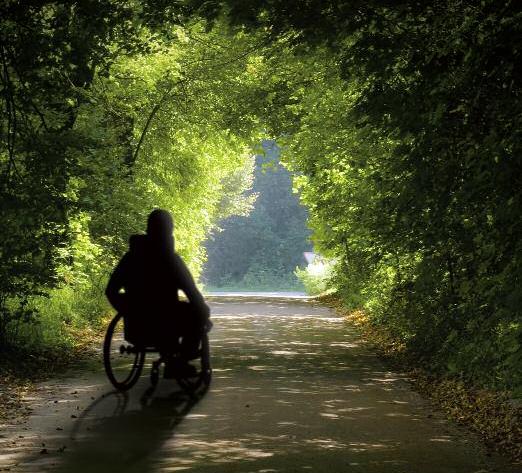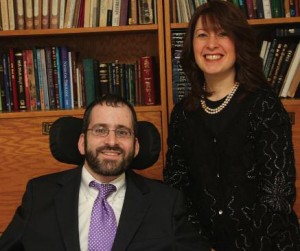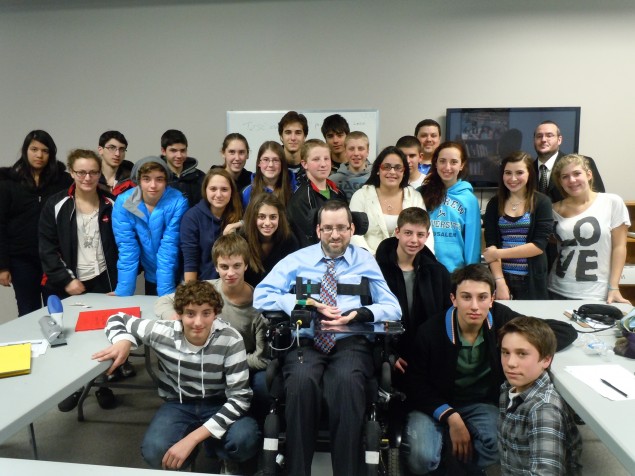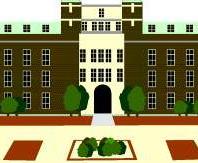What Does God Want of Me Now? Rabbi Yehuda Simes’ Courageous Journey
On the night of June 20th, 2010, a horrific car accident left Rabbi Yehuda Simes paralyzed from the neck down. Crushed by the ceiling of his minivan, he suffered a traumatic spinal cord injury. Had the lesion occurred just one millimeter lower, he wouldn’t have made it.
A popular rebbe at Hillel Academy in Ottawa, Ontario at the time, Rabbi Simes is today not only making it, his spirit has emerged even stronger.
Three years since that harrowing night, Ottawa’s revered rebbe, who is also dean and co-founder of Torah High Ottawa, NCSY’s innovative Jewish studies program for public high school students, keeps defying the experts’ expectations. Despite his quadriplegia, he breathes and swallows on his own, no longer relies on a feeding tube and continues to work diligently to increase his range of motion.
More challenging than his daily physical therapy regimen is the daily struggle to remain optimistic and hopeful, which keeps Rabbi Simes working overtime on his emunah. But Rabbi Simes is determined to ace every daunting “quad moment” (when he falters while attempting to do something he could easily do prior to the accident). His efforts appear to be paying off. Despite his dependence on a “power chair” and 24/7 homecare, Rabbi Simes considers his life blessed, and in the most important ways—richer.
“Every person in this world has struggles,” Rabbi Simes told a rapt audience of community members at Torah High Ottawa’s fifth anniversary celebration in June 2011, twelve months after the accident. “Problems make you stronger, more loving, more understanding. I firmly believe that everything God does is good. You look at me, and it doesn’t look too good, and it doesn’t feel too good, but it’s good.”
Amid the family’s painful new reality came moments of great joy. While Rabbi Simes was still in Ottawa Hospital’s ICU, just a few floors away his wife, Shaindel, gave birth to a baby boy. The ICU and the birthing unit joined forces to make it possible for him to be there when his new son entered the world.
Despite his dependence on a “power chair” and 24/7 homecare, Rabbi Simes considers his life blessed, and in the most important ways—richer.
As soon as little Alter Chanoch Henoch was placed in his father’s lap, Rabbi Simes recited the berachah “hatov u’meitiv” (God is good and does good). “You’ve never seen a berachah like that before,” recalls Shaindel, who was seven months pregnant the night of the accident. “We were both bawling; the fact that this baby was born healthy and that my husband made it to the birth—there was just so much to be thankful for.”
Despite the initial shock, tears and setbacks, Rabbi Simes won’t allow himself the luxury of looking back. “I could be negative, but I prefer to focus on the fact that this world is here to help us grow,” he says. “I don’t think anyone should deny the suffering they have in their hearts, but then turn it into something positive. There is not an iota of doubt in my heart that this is what I need to be a better person. God puts each of us here to do the best we can with everything in our path. If God believes in me, than I have to believe in myself.”
Rabbi Simes views each day as a chance to start fresh, to start anew. “When we wash al netilat yadayim every morning, Hashem returns our souls to us; we are considered a new creation,” he says. “I just go forward.”
Shaindel admits that moving forward requires a lot of patience. “For a long time [after the accident] there was me, and there was ‘my shadow,’” she says. “I would show up at my daughter’s Chumash party, a family Chanukah luncheon, my students’ graduations, but didn’t feel like I was really there. My brain told me, ‘Be happy, your daughter is getting her Chumash today.’ I smiled for the pictures, but didn’t feel like it was me.”
Torah High Gets High Marks
Rabbi Black maintains that even Torah High students who haven’t made lifestyle changes are deeply affected by their exposure to genuine Torah learning. “We have seen success in students who didn’t make changes in high school, yet go on to other outreach programs in university,” says Rabbi Black.
“We have two categories here, the ‘practically frum’—those who take on the mitzvot—and the ‘attitudinally frum’—teenagers who acknowledge the value of observant Jewish life and would like to actually live it but are not supported at home. If you were to ask both types of kids what they want their Saturdays to look like in ten years, they would say they want it to look like Shabbat. These teens want to grow. The challenge is to help them maintain that desire.” To that end, Torah High partners with the OU’s Heshe & Harriet Seif Jewish Learning Initiative on Campus (JLIC), which places rabbinic couples to serve as Torah educators on local college campuses, as well as Aish HaTorah’s Jerusalem Fellowship program, which takes university students to Israel each summer.
Encouraged by the program’s success, Rabbi Black aims to reach between 1,500 to 2,000 more teens per year, and to continue launching programs across North America and beyond. “If there’s an opportunity to start another Torah High, we are 100 percent committed,” says philanthropist Don Ghermezian from Riverdale, New York, who helped finance a few Torah Highs. “I hope that Torah High will be mekarev thousands of kids who otherwise would have no connection to Judaism. It is definitely proving it can.”
Last spring, she experienced an unexpected emotional shift at her elder daughter’s high school graduation—the first public event she and her husband attended together since the accident. “I felt focused and totally in the moment; I really enjoyed myself,” says Shaindel. “Granted, the scene looked a little different; instead of my husband walking beside me, he was in a wheelchair beside me. After the graduation, we went out for ice cream. To be sitting outside at ten o’clock at night eating ice cream with the family was so normal, so real, so ourselves. We realized we could focus on ourselves as people first. I’ve come to a place of acceptance that I never thought I would come to two years ago.”
Rabbi Simes pushes himself to do more and depend on his wife less. “It was a huge milestone when I was able to use my right elbow to press the big button [on the wall] that opens up doors for wheelchairs,” he says. “To actually go to an appointment by myself without an assistant doing that for me, it felt unbelievable, like total independence. Now I have to use that accomplishment to go even further.”Individuals from the community take turns coming to the Simes’ home each day to help Rabbi Simes put on tefillin and get him his siddur. After that, Rabbi Simes says he’s “good to go” with his davening, now that he is able to turn the pages on his own—another triumph.
Everyone’s Pain—Everyone’s Growth
Rabbi Simes and his wife attribute both the physical and spiritual gains to the constant flow of generosity and concern expressed by the Ottawa Jewish community. The day after the accident, community members organized a massive prayer service, as well as weekday and Shabbat meals, babysitters, household help and drivers for the family. The Simes family asked that individuals enhance their Shabbat observance as a merit for Rabbi Simes’ recovery.
His question is not “Why did this happen to me?” Rather it’s “What does God want of me now?”
Those who responded first to this request were Rabbi Simes’ staunchest fans—his students. “I tried not turning on lights on Shabbat in his honor,” says Abigail Freeman, twenty, a student at McGill University who attended Torah High Ottawa. “He’s an amazing teacher; he didn’t lecture. He asked our opinion and he always listened, valuing what we said.” She made sure to visit him before going off to university. “He asked me about my summer and the college courses I would be taking. He was sitting in his wheelchair, not able to move, talking to me about me,” she says. “That was typical Rabbi Simes, always positive, caring about others, continuing his life as best he can with his belief in God and Judaism.”
Tobin Kaiman, twenty-four, another Torah High Ottawa graduate, currently serving in the IDF, concurs. “Most people in his condition tend to fall into depression,” he says. “Watching him daven, you could see how connected he is to God, before and after the accident. I would like to emulate that. If it weren’t for Rabbi Simes, I wouldn’t be on this [Torah-observant] path.”
Originally from St. Paul, Minnesota, Rabbi Simes, shy by nature, began his teaching career upon graduating from Yeshiva Chofetz Chaim of Queens, New York. He taught at Yeshiva Central Queens and at Yeshiva Tifereth Moshe, both in Queens.
In 2002, Rabbi Simes and his family moved to Ottawa, following the Yeshiva’s philosophy that a rebbe “should serve as a big fish in a small pond.” He quickly became one of Hillel Academy’s most beloved teachers. His infectious passion for Judaism and his genuine love for every student earned him Ottawa’s prestigious Grinspoon-Steinhardt Award for Excellence in Jewish Education in 2007, as well as the admiration of everyone he encountered.
He’s a master of communication,” says Bram Bregman, executive director and co-founder of Torah High Ottawa. “He thinks about how the other person will hear his words. Every lesson is interactive, engaging and well-organized. Kids look forward to his classes. His teaching tenet is: if it’s not working, it’s not them; it’s me.”
Moving Out—Moving On
As Rabbi Simes’ daily schedule becomes more predictable, questions arise about how the new reality will affect the rest of the family (they have nine children, k”ah). “After the injury, we were all focused on healing my body,” Rabbi Simes says. “They didn’t think that much about the need to heal themselves,” he says. “They had to come to an understanding about what this new life means for the entire family—that it’s their trauma as well. With everybody putting in the effort, my relationship with the children has become much more normalized. They have done wonderfully, beyond what anyone could have imagined.”
Their youngest child, who turned two in September, enjoys a very different kind of interaction with his father than his brothers and sisters had at his age. “His father can’t pick him up, but he can sit on his Abba’s lap and stroke his face and give him a hug,” says Shaindel. “When his Abba calls him over for a berachah on Friday night, he comes running and holds his head just at the right position so that my husband can reach him. If my husband and I truly believe that this is what’s supposed to be, then we are going to be okay with it. And if the children see that we’re okay with it, then they will be too.”
This past July, the Simes family left their split-level home for a new, completely wheelchair-accessible house. “Everything is on the first floor,” says Shaindel. “My son asked me, ‘You mean Abba can come in the kitchen?’ He hadn’t been in the kitchen for two years. We have an elevator to the basement, where he could give shiurim. And now we have room for exercise therapy machines. We felt that we were on the brink of a new beginning.”
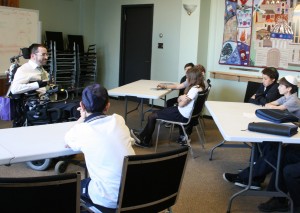
Rabbi Yehuda Simes teaches his seventh grade class at the Ottawa Jewish Community School, formerly the Hillel Academy.
Photo: Nicola Hamer/Ottawa Jewish Bulletin
Grateful to begin a “new chapter in their lives,” Rabbi Simes has begun teaching again. He is also a guest speaker at Torah High Ottawa once a month. “Just months ago, he was asking, ‘What am I going to do now?’” says Shaindel, who has also returned to teaching at Torah Academy of Ottawa. “We don’t take things for granted. Simple things take on so much more meaning. The kids had a function at school and we were able to go; I now cook for Shabbat. You have to really live each day and see that each one has its opportunities.”
Just How Effective Is Torah High?
Recently, an independent study assessed the impact of Torah High programs, and found significant positive changes in students’ attitudes and beliefs toward Judaism:
• 60 percent of respondents were more inclined to date a Jewish man/woman.
• 64 percent of students said they were likely to get involved in Jewish life on campus.
• Close to 70 percent of students felt more strongly about providing their future children with a Jewish education.
• More than 60 percent of students reported that since enrolling in Torah High, they are more likely to visit Israel.
• 74 percent felt a greater connection to Torah and Torah values as a result of Torah High.
Rabbi Simes no longer speaks to his classes about the accident and how it affected him. “They can draw their own conclusions from what they see, which is pretty obvious,” he says. “It’s a huge challenge not to focus on myself, thinking about my own body. Once I started looking outward, I saw so much chizuk around me; it’s just up to us to find it.”
Rabbi Simes’ bold attempts to reenter the world serve to intensify his relationship with God. “I feel closer to Hashem, without a doubt—much closer,” he says. “I’m asking for His help more and more; it’s tremendously calming. When davening in the past, I focused on the difficulties. I now realize that there is a fine line between davening for health and going overboard and thinking about it all the time; it impeded my moving forward. I feel siyata d’Shmaya; it’s unbelievable how often He’s there helping me.”
A number of months ago, while attending a Jewish Unity Live event, a community-wide Torah learning celebration run by JET (Jewish Education Through Torah) in Ottawa, Rabbi Simes learned that reentry into society doesn’t necessitate putting one foot in front of the other. At the close of the evening, the participants got up to dance. “I went in circles in my wheelchair and everyone stood around me clapping,” Rabbi Simes says. “I didn’t like that; it shouldn’t be about me. I joined the outside circle and by controlling the speed of my chair and maneuvering it to go along with the dancers, I participated. I am a person, not a quad.”
As he did before the accident, Rabbi Simes continues to reach out to help others. “Any Jew who meets him—from the most unaffiliated or even anti-Orthodox—are inspired by him. He’s such a kiddush Hashem,” says Bregman. “It’s his kindness, the way he speaks to people with such understanding. He gets letters and e-mails from both Jews and non-Jews. His question is not ‘Why did this happen to me?’ Rather it’s ‘What does God want of me now?’ That incredible attitude is what inspires others.”
Known for their guest-filled Shabbat table, the Simes couple look forward to opening their home again. “When my husband made Kiddush for us for the first time since the accident, I felt like I was getting a glimpse of what the future could look like,” says Shaindel. “There were times when I asked myself, is it worth the struggle? But I knew I wouldn’t go down without a fight. I was going to do whatever I could to make this work. My husband and I have a whole future ahead of us. And I’m proud to be there beside him along this journey.”
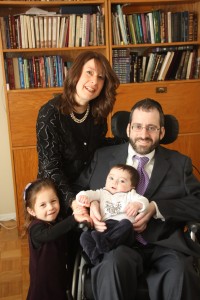
The couple with two of their children. The younger child seen above was born soon after the accident. Photo: Issie Scarowsky
To listen to interviews with Rabbi Yehuda and Shaindel Simes, visit ou.org/savitsky/ysimes and http://ou.org/savitsky/simes.
Bayla Sheva Brenner is senior writer in the OU Communications and Marketing Department.

